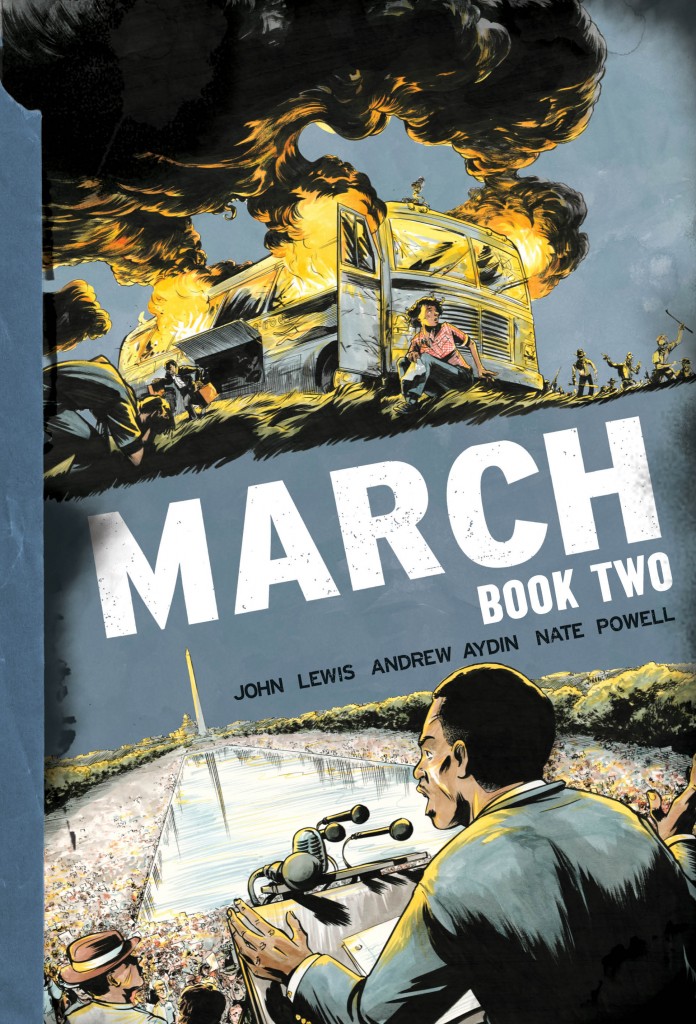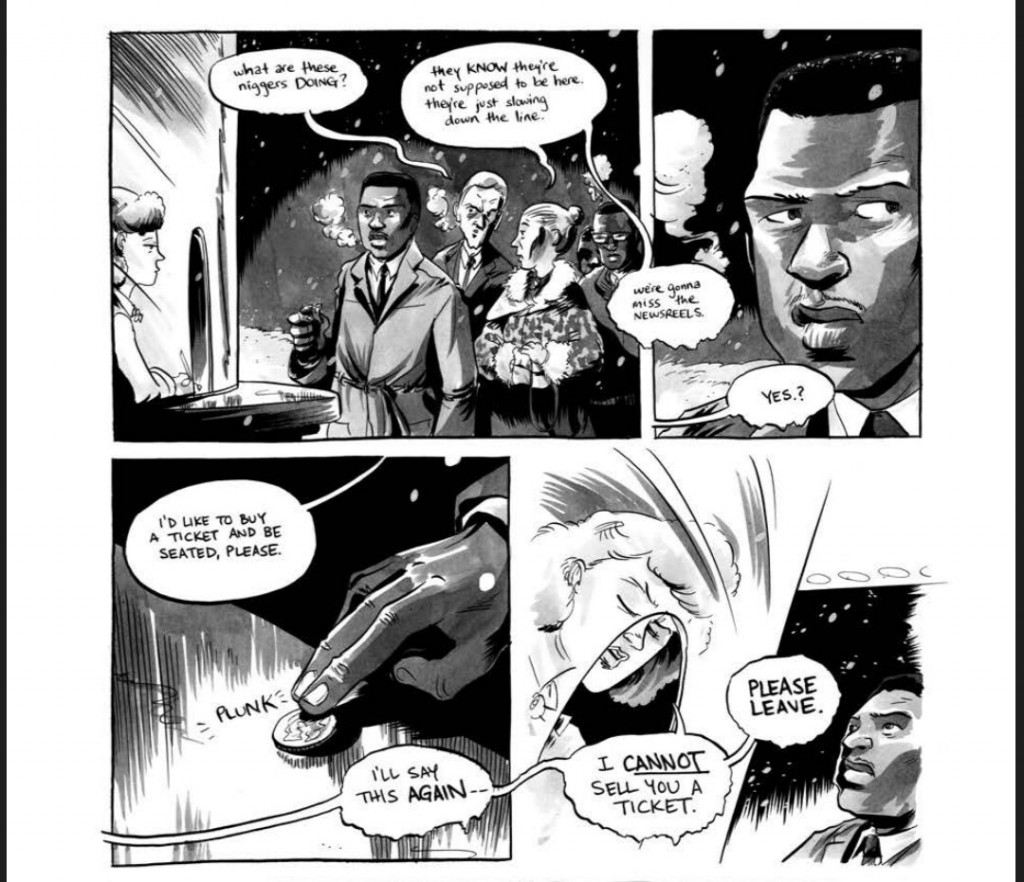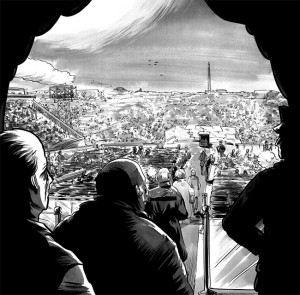There’s a powerful vignette in the opening pages of March: Book One, the autobiographical graphic novel from Congressman John Lewis, that depicts a moment from the Selma voting rights march, beat for beat presaging an identical moment in Ava DuVernay’s acclaimed film Selma. In the film, as lensed by incredible cinematographer Bradford Young, the standoff between protesters and Alabama police feels like something out of horror movie, a suspenseful respite before what is sure to be a vicious and violent sequence. As drawn by Nate Powell, the opening of March serves as a preamble to a prevailing theme, that of an adherence to non-violence, not just as a protest tactic, but as a way of life. This is the key theme that drives Lewis’ life story.
Book One, the first of a trilogy, began the life story of John Lewis (portrayed in Selma by actor Stephan James) as written by himself with assistance from Andrew Aydin, and beautifully illustrated by Nate Powell. Using the narrative device of Lewis having a conversation with two young students to hop between his early life and present day work in Congress, it sidestepped a lot of the pitfalls of biographical stories simply by virtue of existing on the comics page. Powell’s ability to lay out panels with a dreamlike quality that blends memories and emotions allows for Lewis’ story to sustain a narrative cohesion between looking back and facing forward.
There’s a sense of the images being literal manifestations of Lewis’ recollections and musings, as if they spring forth fully formed from his mind. Powell breaks moments down to their most symbolic, resonant elements, presenting juxtapositions between words and pictures that call to mind Gavin Aung Than’s Zen Pencils webcomic, only replacing smarmy, self serving platitudes with legitimate dramatic heft and truly affecting zeal. Congressman Lewis was inspired to undertake this project by Martin Luther King and The Montgomery Story, a 1950s comic that expertly used the medium of sequential art to help the mythic weight of the civil rights movement spread far and wide. It’s amazing that he found such a worthy artistic collaborator in Powell, who pulls double duty here, illustrating a biography first and crafting some winsome educational material second.
March: Book Two picks up where the last one left off, leaving behind Lewis’ formative years to focus on what amounts to the Empire Strikes Back chapter in his ongoing saga, exploring his early twenties when he first comes into serious contact with future collaborators like Martin Luther King Jr, as well as Robert and John F. Kennedy. One of the most engrossing things this story brings to the current conversation about social justice is the sacrifice it takes to dedicate your entire life to a cause, whatever it may be. We read along as Lewis struggles with the pull of his own calling tearing him from the life his family had been accustomed to. We follow along as Lewis leaves the farm behind to study abroad, before coming into contact with Dr. King and other important figures from the movement, when he is swept up in the righteous fervor of changing the world around him. From the sit-ins at segregated lunch counters he helped organize with the Nashville Student Movement to being one of the original Freedom Riders, Book Two culminates in the controversy surrounding the speech Lewis delivered at the march on Washington, right before Dr. King’s own “I have a dream” speech. It leaves us on a down-note cliffhanger, at a time in our own history when all seemed lost.
It would be very easy to paint a one-dimensional portrait of the civil rights movement, solely pitting protesters against the prejudiced establishment, but March: Book Two explores a lot of the thornier complexities of the issues at hand. There’s a disconnect between the older guard in figures like Thurgood Marshall and Lewis’ youth movement that is mirrored in today’s conflicts between the social media-savvy protesters of today and Al Sharpton’s bygone contingent. I was also struck by the way Baynard Rustin’s homosexuality is addressed as a liability within the movement late in the book. It’s a passing reference, but it hints at further intersectionality within the larger discussion of systemic oppression in a way that is very fascinating. Similarly touched upon (without dwelling needlessly) are the role of white allies within the cause and the fragmented ideals among the leadership, as depicted in the late sequence of Lewis’ speech being rewritten and picked apart by the rest of The Big Six (a group of civil rights leaders including MLK and Lewis himself).
Not enough can be said about Powell’s art, and his ability—specifically with regards to the use of lettering—to convey so much within a string of conjoined frames. His use of the printed word to exaggerate speech, enhance his already considerable “acting” skills, and create layers of informational density on the page never cease to astonish. His art transcends the limits of typically cinematic comic book techniques, creating passages of the book that are as thrilling and engrossing an example of the power of comics as any you could name. There’s a fantastic sequence set in jail, where Lewis and his compatriots cajole and taunt some guards through song, that just flies off the page. It’s so vibrant, driven by an off kilter, jazzy rhythm. Elsewhere, he dials up those same techniques to portray the extra-real violence of the pervasive police brutality, or significantly dials them down to show the seemingly mundane day to day racism of not being able to buy a movie ticket.
His is a style a few shades past realism that exaggerates the form enough to fully convey the absurd tragedy of the time. A vivid, cinéma vérité style could probably better capture the time as it was, but his loose, wavy lines do a much better job of getting across how it must have felt.
The sole criticism here is the double-edged sword of using Barack Obama’s inauguration as the central bookend device in this volume. The somewhat dubious transitions these sequences bring to the table range from the honestly chilling (as in the full page splash of Inauguration Day itself, a beautiful representation of how far the movement has come) to the confounding (as in the moments when President Obama himself appears, taking you out of the symbolism of the moment and thrusting you into one of his random Savage Dragon cameos). While it’s inarguable that drawing a line from the civil rights movement to the nation’s first black president has a certain level of dramatic power, it ultimately pales in comparison to the more challenging narrative that surrounds these flash forwards.
Ultimately, March: Book Two is an important use of the comics medium, telling a timely and heartfelt tale of injustice, integrity, and the personal sacrifice required to change what you can no longer accept. It takes the life story of one extraordinary man and presents it as an everyman’s journey, placing his accomplishments on a pedestal without neglecting to remind you of his humble beginnings. It’s a handbook for anyone who looks at the news or outside their windows and sees a world they can’t abide. A handbook that, sadly, still needs to be put to use today.
March: Book Two hits shelves tomorrow.







